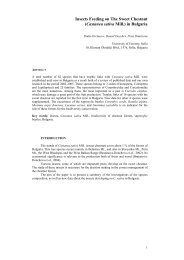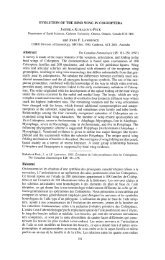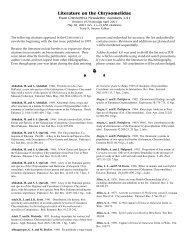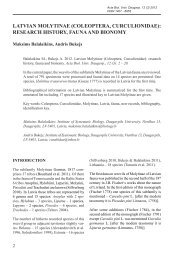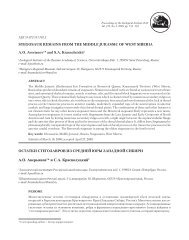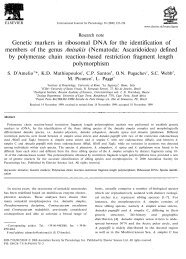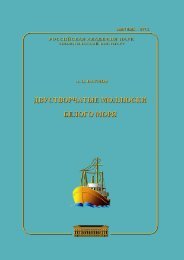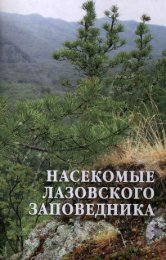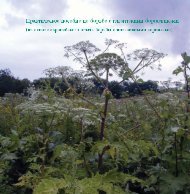114 NADEIN, K. S.: <strong>Revision</strong> <strong>of</strong> <strong>the</strong> <strong>genus</strong> <strong>Mniophila</strong> <strong>STEPHENS</strong>, <strong>1831</strong>Fig. 2: <strong>Mniophila</strong> muscorum (KOCH): Aedeagi. A, C, F – ventral view; B, D, G – lateral view; E, H – aedeagalapex, ventral view. Scale bar: 0.5 mm.base. Pronotal surface covered with shagrination; punctation large, sparce, shallow, weakly visible.Elytra with greatly variable punctation. Usually punctation well developed, small, dense, striaeconfused; secondary punctation well developed, <strong>of</strong>ten as large as strial. Rarer strial punctationregular and secondary punctation smaller or almost indistinct. Legs thickened; tibiae straight orweakly curved; hind femora wide. First protarsomere <strong>of</strong> male usually short and moderately narrow.Aedeagus (Fig. 2) ventrally with apical third short with straight margins and nearly straight apexwith denticle to elongated, narrow, with narrow apex without denticle. From lateral view apicalthird clearly gradually narrowed to apex, sometimes wider.Body length – 1.20-1.68 mm, width – 0.89-1.21 mm.Differential diagnosis:Differs from M. bosnica in structure <strong>of</strong> aedeagus (Fig. 2): apical third in posterior view elongatewith straight margins instead <strong>of</strong> short with round margins, apex straight or nearly straight with adenticle instead <strong>of</strong> apex rounded without denticle (Fig. 3J, K); body more elongate (Fig. 1A-E); eyesconvex (Fig. 1F); pronotum longer (Fig. 1G); first metatarsomere thinner and shorter (Fig. 1K),first protarsomere <strong>of</strong> male shorter (Fig. 1L), colouration <strong>of</strong> <strong>the</strong> body darker, dark brown to black,usually with weak green luster; elytral punctation usually denser, punctation <strong>of</strong>ten confused,secondary punctation well developed, usually as large as punctures in striae. From M. tauricasp. n. differs in structure <strong>of</strong> aedeagus: apex usually elongate, with narrowing straight margins in
Beitr. Ent. 59 (2009) 1115posterior view or apical third with straight margins instead <strong>of</strong> sides toward apex parallel-sided,apical 1/4 with straight margins (Fig. 5K), denticle always present and well developed instead <strong>of</strong>denticle short or poorly developed; shagrination <strong>of</strong> <strong>the</strong> head more developed; eyes more convex;legs thicker; hind femur broader (Figs 1H, 5D); punctation <strong>of</strong> pronotum usually more developed;differs also in <strong>the</strong> shape <strong>of</strong> pronotum.Discussion:<strong>Mniophila</strong> wroblewskii WAŃKOWICZ was described as a separate species and later was regardedas a variation <strong>of</strong> <strong>Mniophila</strong> muscorum by WEISE (1883). This variation was also recorded fromCaucasus and Crimea (WEISE 1906; HEIKERTINGER & CSIKI 1939; DOGUET 1994). Study <strong>of</strong> <strong>the</strong>material from Caucasus and Crimea revealed no <strong>Mniophila</strong> muscorum in <strong>the</strong>se regions but threespecies new to science. The name “wroblewskii” was based on European specimens <strong>of</strong> <strong>Mniophila</strong>and treated as variation <strong>of</strong> <strong>Mniophila</strong> muscorum. Therefore, this name cannot be used for one <strong>of</strong><strong>the</strong> new species from Caucasus or Crimea. Study <strong>of</strong> <strong>the</strong> variability <strong>of</strong> <strong>Mniophila</strong> muscorum revealsnei<strong>the</strong>r forms and variations nor subspecies. The main basis for description <strong>of</strong> <strong>the</strong> new forms orvariations was <strong>the</strong> elytral punctation character. The state <strong>of</strong> this character is significantly variableand <strong>the</strong>re is no correlation with geographic distribution. The character <strong>of</strong> punctation varies greatlyat <strong>the</strong> level <strong>of</strong> population. There are individuals with more or less confused or regular punctationin <strong>the</strong> same population as well as with reduced or developed punctation. Therefore, I cannot agreewith MOHR (1966) and STREJČEK (1993) on <strong>the</strong> subspecies status <strong>of</strong> <strong>Mniophila</strong> wroblewskii.The same concerns also <strong>Mniophila</strong> muscorum fa. seriatopunctata described by ROUBAL (1932)and <strong>Mniophila</strong> muscorum fa. fortepunctata described by HORION (1939). These were described asdefinite forms and cannot be recognized as a species or as a subspecies (ICZN 2000, Arts. 45.5,45.6, 45.6.4). The descriptions <strong>of</strong> <strong>the</strong>se forms were based on intraspecific variability <strong>of</strong> elytralpunctation and <strong>the</strong>y are not localized geographically.<strong>Mniophila</strong> bosnica APFELBECK, 1914(Figs 3, 9)<strong>Mniophila</strong> bosnica APFELBECK, 1914: 446. – GRUEV 1979: 138, figs 2a, b (species level status restored).– GRUEV & DÖBERL 1997: 240 (distribution, bibliography). – WARCHAŁOWSKI 2000: 25 (description,distribution). – GRUEV 2001: 21 (checklist).<strong>Mniophila</strong> muscorum var. bosnica APFELBECK. – HEIKERTINGER 1930: 1346. – HEIKERTINGER & CSIKI 1940:522 (catalogue).<strong>Mniophila</strong> muscorum bosnica APFELBECK. – MEDVEDEV 1970: 317 (subspecies level status).Type material:Syntypes: Bosnia. Trebević, Apf. / TYPUS, 1 specimen. – Zvijezda / TYPUS, 2 specimens.Type material is deposited in <strong>the</strong> National Museum <strong>of</strong> Bosnia and Herzegovina, Sarajevo. Notexamined.Type locality: Bosnia (South).O<strong>the</strong>r material examined:Great Britain: Power. Darenth., 8 specimens (NHML). – Surrey. Leith Hill. 16.VI.1951. J. T. Salmon / inmoss, 3 specimens (NHML). – Chatham, Kent. G. C. C., 1 specimen (NHML). – H. Donisthorpe. B. M.1934-4., 3 specimens (NHML). – Oxford Kent 26.3.70 / in moss, 5 specimens (NHML).France: St. Béat H.-Garonne, 7 specimens (ZIN).




